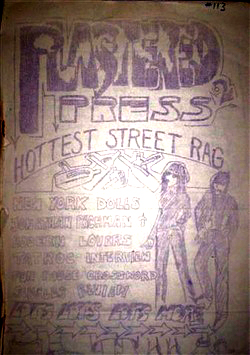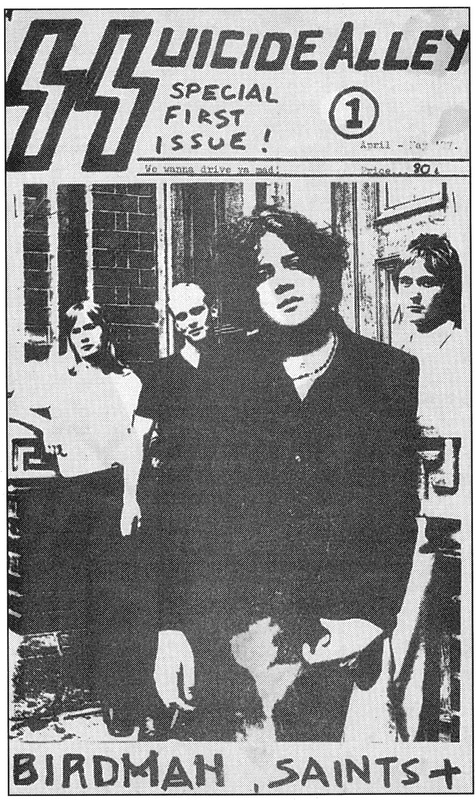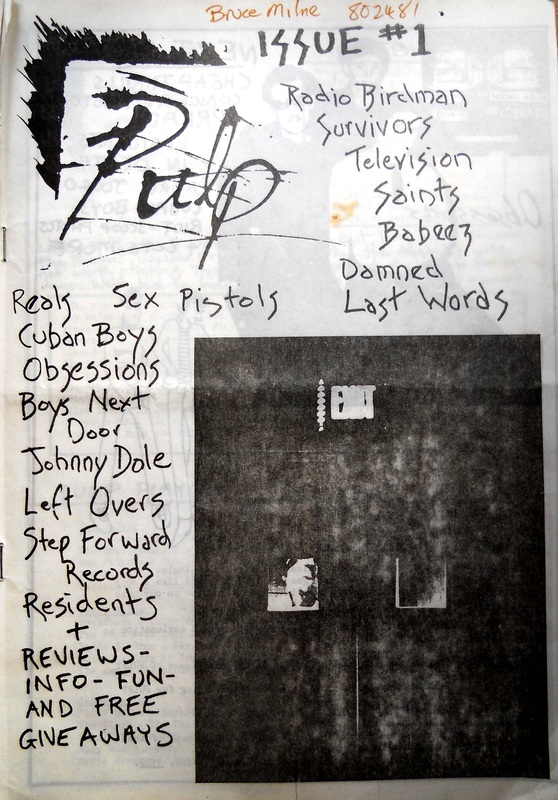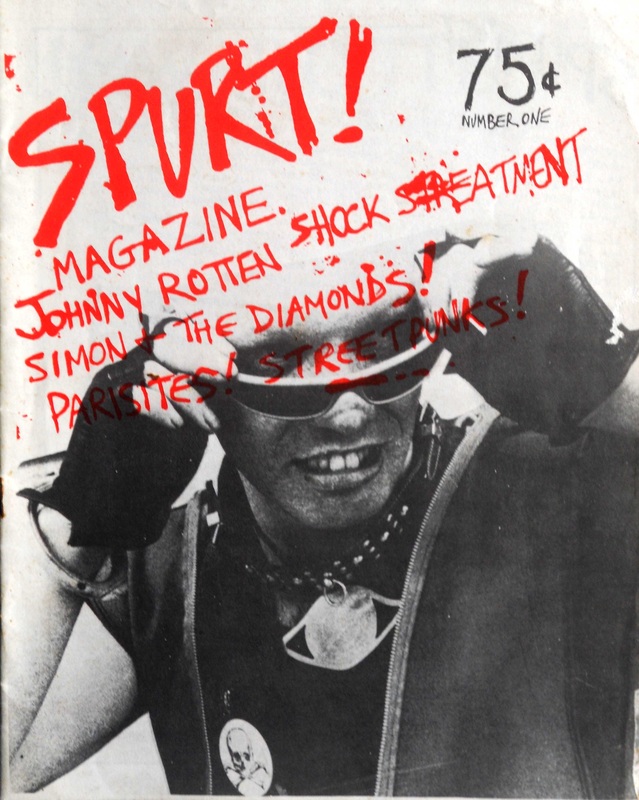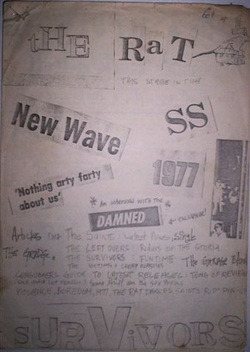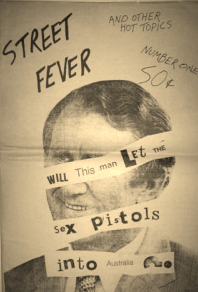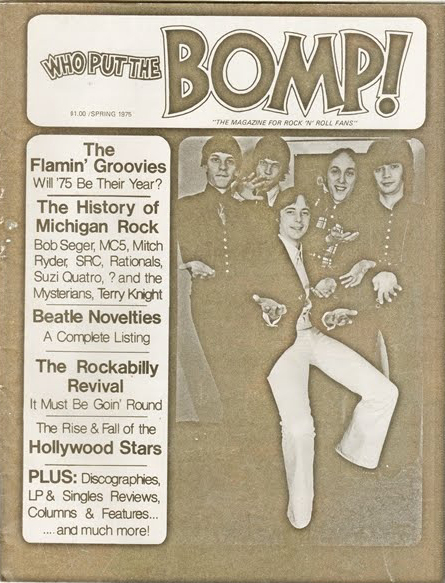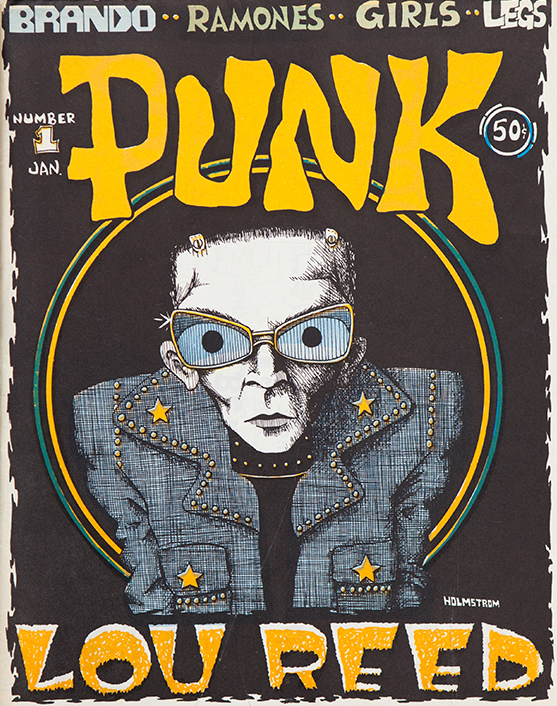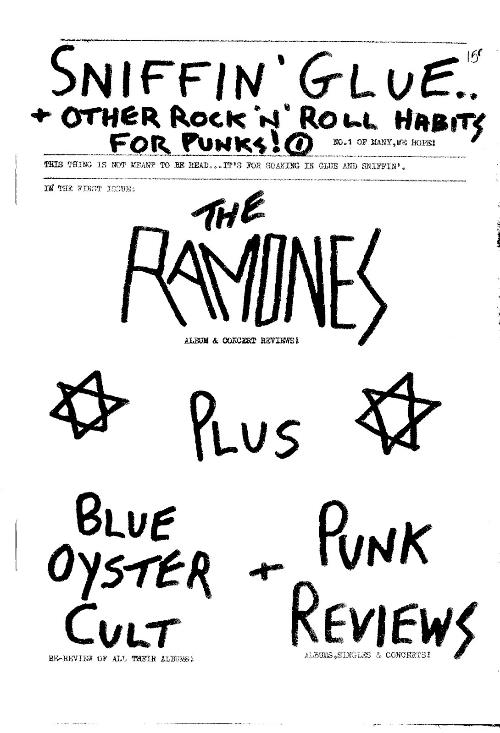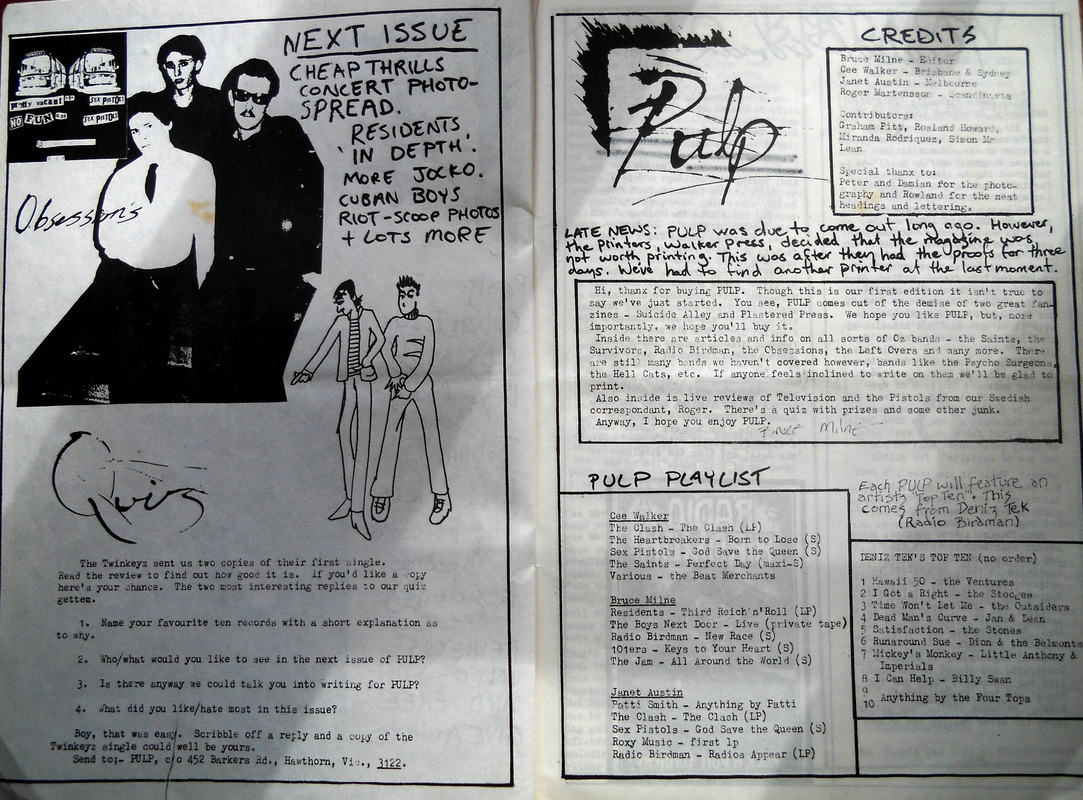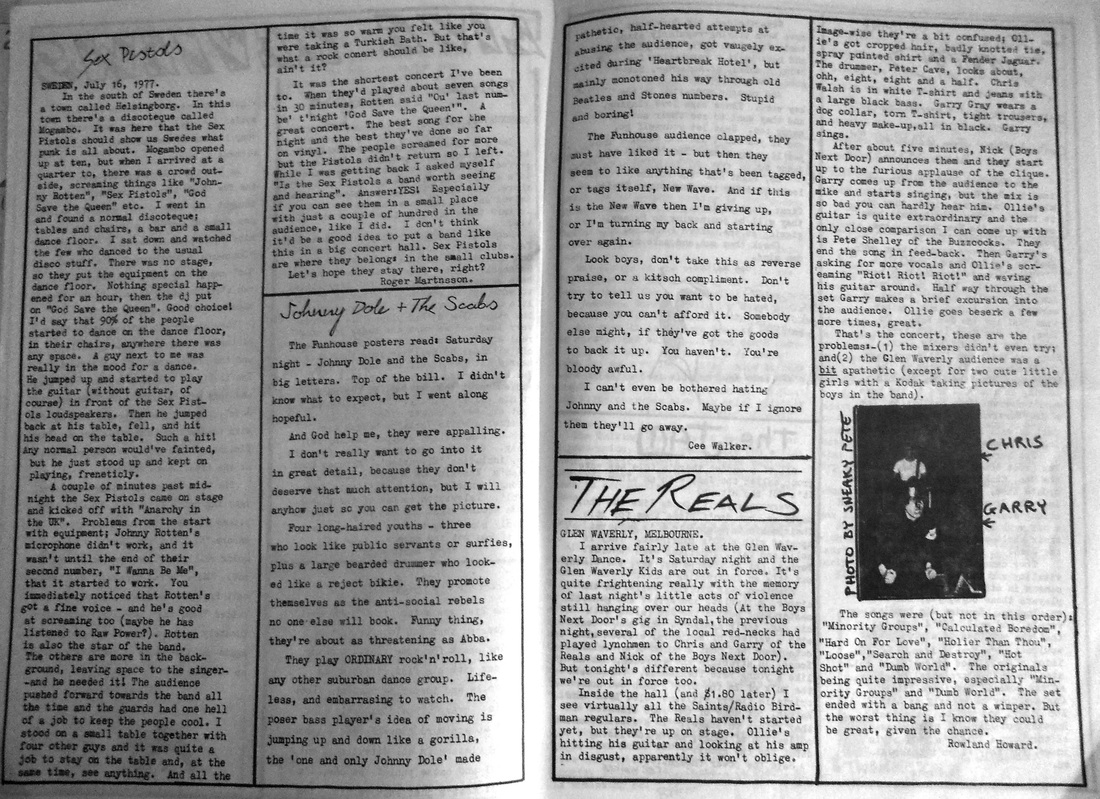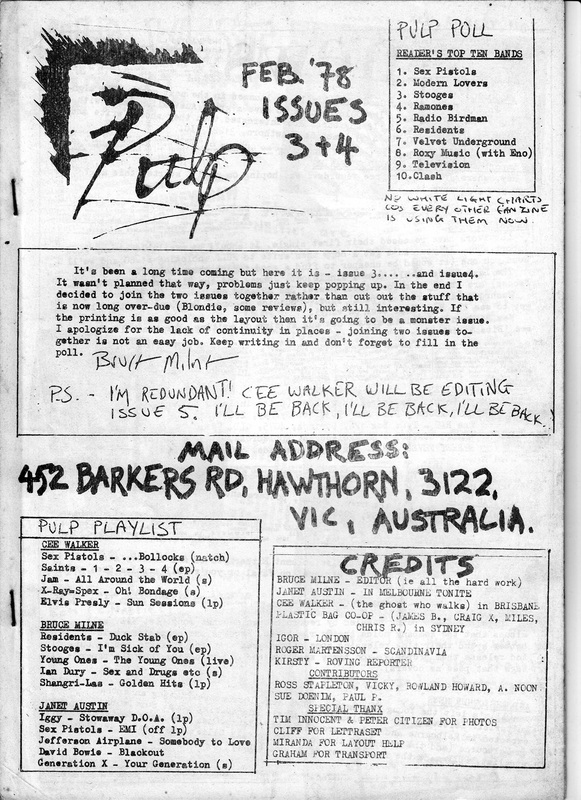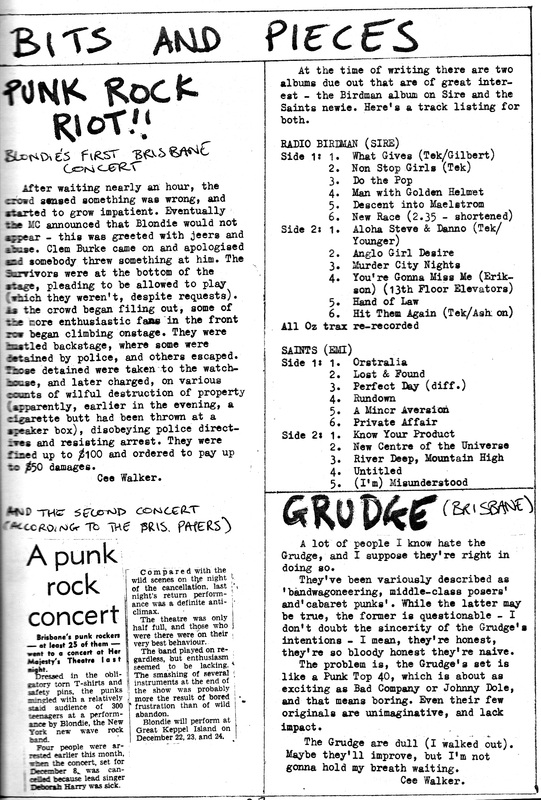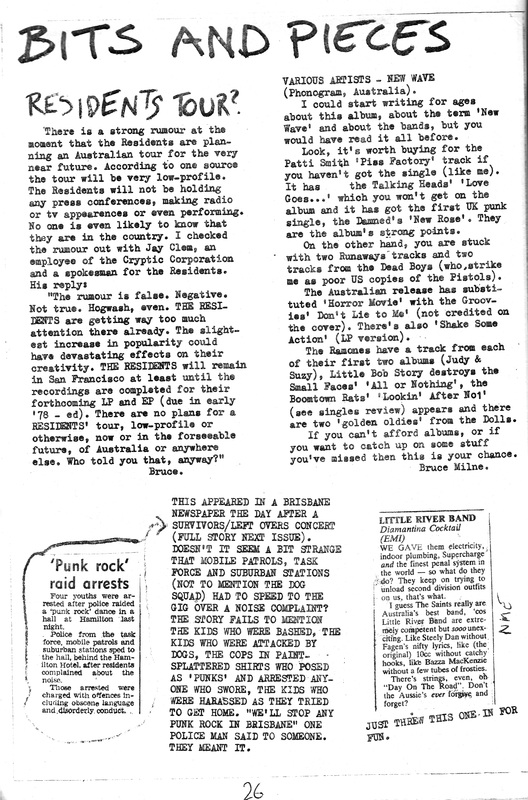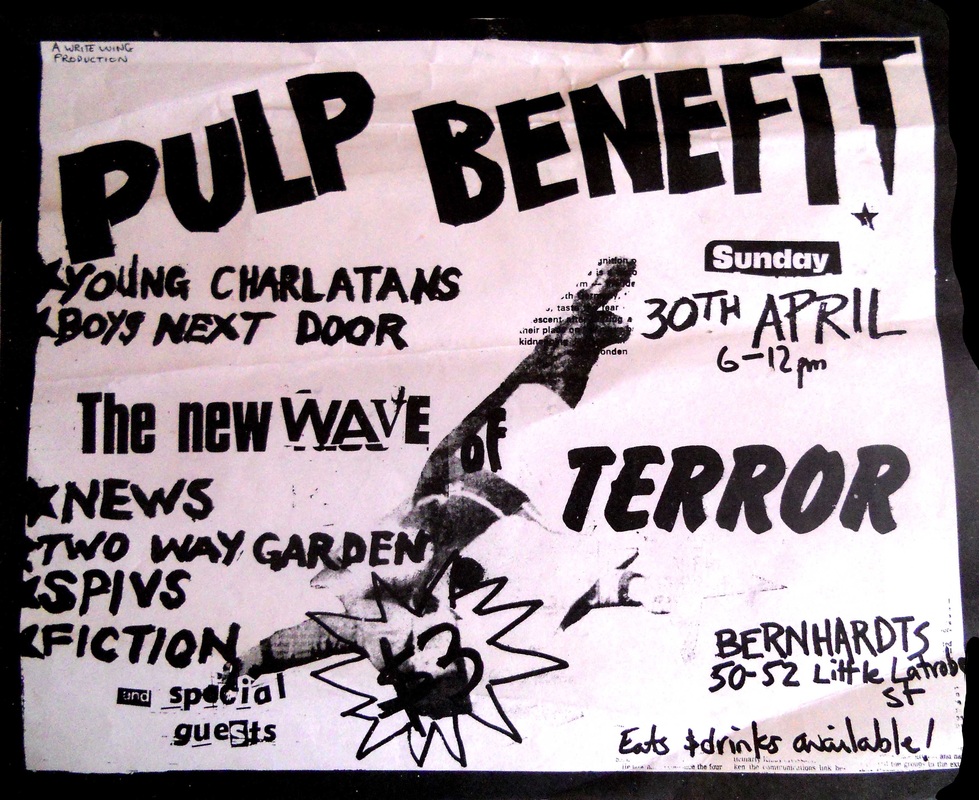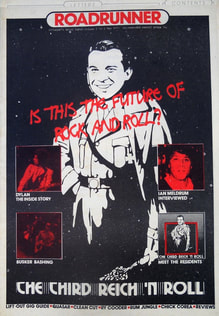fanzines
|
Fanzines are where I started, where a lot of writers and artists get started. The emerging sounds of punk rock and their underlying DIY ethic motivated me to print my own first fanzine, SSuicide ALLey, in collaboration with (the late) Andrew McMillan, in Brisbane in 1977. In fact, given the dateline that this first (and only) issue carries (April ’77), I think I can pretty confidently assert that SSuicide ALLey was Australia’s second punk fanzine, after Bruce Milne had got out the first, the first (and only) mimeographed issue of Plastered Press, possibly even as early as late '76.
|
|
I want to try here to put an accurate timeline to the first couple of years of punk publications in Australia. Because it has become contested ground, and I want to redress some of the misinformation that's one of the inevitable casualties of history wars. Get that accurate acknowledgement out there, that it was Bruce who put out Australia's first (almost-pre) punk zine, not me, and properly plot the bibliographical developments thereafter... In Australia as around the world, there was a whole amphetamine rush of punkzines in '77. What the timeline says is that after the above first two, Plastered Press and SSuicide ALLey, the third zine to emerge was Pulp, which was of course the union between Bruce and I, a sort of trans-capital (Melbourne/Brisbane) superzine, and it was only after Pulp that all the other 1977 start-ups followed, including Sydney's Spurt and Self Abuse, Brisbane's The Rat, Melbourne's Alive'n'Pumping, Perth's Remote Control and Adelaide's Street Fever. |
|
Back then, the world wasn't like it is now, with all its connectedness. Here in Australia we were deeply isolated. One lifeline for me was Rock Scene, the magazine edited out of New York by Richard and Lisa Robinson, which was where I first saw photos of Iggy, Patti Smith and the Ramones, and which was somehow sometimes even stocked by Brisbane newsagents. (To see an extraordinary archive of every page of every issue of the amazing Rock Scene between 1973-'82, go here.) I didn't much get to see Creem because it wasn't carried by local newsagents - more likely Circus, which I quickly grew to hate - but you could get the NME, and I grew to favour its in-house prophet of punk, Nick Kent. I wasn't into Rolling Stone, with all its West Coast soft rock, and I had no awareness (until later) of American and British zines like Bomp!, Trouser Press, Let it Rock or Zig-Zag. When John Holmstrom and Legs McNeill started publishing Punk out of New York in late 1975, and similarly when Mark P started publishing Sniffin' Glue out of London the following year, these for me were heard-about but not seen. It wasn’t till the import stores - which in those days for me largely meant Rocking Horse in Brisbane - started getting in more of this ephemera that I started actually seeing any of it. But the principle was simple enough anyway: Write up some stuff, lay it out on a page, print and staple together a few copies, and sell them through the record stores. |
|
I guess I needed the boost in confidence that collaborating with Andrew McMillan on SSA gave me. He was already sending a few stories to RAM, then the leading rock rag in the country. Inspired by Mark P and Dee Dee Ramone, I took the pen-name Cee Walker, which some people still occasionally call me (and I quite like it!), and I wrote an equivocal review of Radio Birdman that caused an enmity that still persists in some quarters to this day (read it here!). We printed up the first issue of SSuicide Alley (in foolscap format; that's how naive I was) and in April 1977 - just after the Saints had left Brisbane for Sydney on their way to London - I took the train south. In Sydney, where I crashed at the Saints' doss-house along with my old mate from Brisbane Jeffrey Wegener, I fronted up in the record shops - most notably White Light, whose handbills were like broadsides themselves - and traded copies of the zine for new singles. I went and saw Radio Birdman (for the one and only time) at the Royal Easter Show, and I saw a few gigs at their venue the Oxford Funhouse (including one by Johnny Dole and the Scabs - review below). Moving on to Melbourne, I sold copies of SSA to Keith Glass at Archie & Jugheads (just before it was renamed Missing Link), and the first three people I met there were Bruce Milne, Rowland Howard and Ollie Olsen. Bruce I'd already connected with by answering an ad in RAM selling Plastered Press; Rowland was his friend from school who'd helped on the zine and was trying to get a band together; and Ollie was in a new band called the Reals. I didn't see the Reals on that visit to Melbourne, nor the other two new bands on the scene - NEWS and the Boys Next Door - but I connected in a way I didn't in Sydney, which seemed old and hoary by comparison, and a link was forged that became the virtual foundation of a synergy that the exhibition "Melbourne><Brisbane: Punk, Art and After" at the Ian Potter Gallery in Melbourne in 2010 all too conspicuously overlooked. When I got back to Brisbane in May 1977 and Andrew McMillan announced he was leaving for Sydney to take up a staff job at RAM, I got straight back onto Bruce in Melbourne and suggested we kill off our respective erstwhile zines and join forces to create Pulp, the name I recall Bruce must have come up with. The first issue of Pulp, complete with masthead logo designed by Rowland Howard, and with a lot of help from other people including most notably Janet Austin and Bruce's brother Peter Milne, came out in August '77. Click through the below to read sample pages, or see the issue in full here. |
|
I was still living in Brisbane, working in the art studio at an advertising agency (which helped putting the zine together), and I'd also started writing music stuff for Semper, the University of Queensland students' rag that was stepping up its profile in the face of competition from the Cane Toad Times (which I always thought was hippy fodder anyway). Bruce and I did a couple of issues of Pulp by mail (as you did in those days), while the deluge began. But apart from Ian Hartley's Spurt, which was launched out of Sydney before the year was through and continued to publish till 1979 - and which was definitely the best-looking and most professionally-produced Australian punkzine of them all, but light-on, we felt, in terms of content (its inaugural issue boasted cover star Simon Reptile, which was way too Rocky Horror/punk cabaret for us) - most of the other zines that sprang up in '77 were shooting stars that neither surpassed a single issue nor left a larger legacy. |
|
Adelaide's Street Fever, however, was an exception, and it would have ramifications beyond its own one-issue lifespan. In early 1978, upon the publication of the third issue of Pulp - which was in fact a double-issue, 3+4 - I moved to Melbourne, where I had friends like Bruce and Jeffrey Wegener, who'd moved there from Sydney to join Rowland and Ollie in the Young Charlatans, who were managed by Bruce: this was a lot of my inner circle for the next couple of years. But as Bruce and I started working together on a 3RRR radio show called Know Your Product, and I continued to write for Semper up in Brisbane, we somehow never managed to get out a fifth issue of Pulp. We tried - we even put on a benefit gig with all the best bands in town playing, as the flyer below shows - but when we got word about this mob in Adelaide who'd done Street Fever talking about trying to get up a new national magazine, what would become Roadrunner, Bruce and I got on a train and went over to Adelaide to meet them. I recall another time I hitch-hiked over there; we decided to throw our lot in with them, and Bruce even moved over to Adelaide for a while. That aborted fifth issue of Pulp was the seed that eventually flowered in my first book, 1982's Inner City Sound, right down to even some of the artboards I'd already done! Pulp#5 was lost for many years, until 2020 when out of the blue I was contacted by Melynda von Wayward, convenor of punkjourney. She had rediscovered, remarkably, some of the other remaining artboards from the aborted issue and wanted to reconstruct it for her amazing resource. So I said, Of course! and with my help we got it back to a reasonable facsimilie of what a lot of the issue would have looked like. You can see it here. |
|
When Roadrunner went properly national in '79, it quickly overtook Juke as the Chrysler behind GM and Ford in Australia's Big 3 of rock rags, one of its Three R's trailing only RAM and Rolling Stone, and in 1978/'79 I served as its 'Melbourne editor'. To learn more about Roadrunner (and the Countdown magazine, for which I also later wrote), read a fond reminiscence by Donald Robertson here. The fanzine scene continued to proliferate, with Sydney, in '78, adding Autopsy and Choke to its regular diet of Spurt and Self Abuse, Brisbane offering up Nice Images and Fad, and Adelaide offering up DNA - but most of these, again, with the conspicuous exception of DNA, were short-lived; Harry Butler's DNA continued to publish all the way up to 2006! (There's a little more nice stuff on early Oz zines here at punk journey.com, and here at Scotti FMR's Fantastic Mess Records site.) Just before Xmas 1979, I followed my then-girlfriend to Sydney - and almost overnight, found myself a semi-professional freelance journalist, working for RAM and Rolling Stone as well as Roadrunner, and even getting a job stringing for a real newspaper, the Adelaide Advertiser. Seldom did I return to unpaying zines again. The 1980s saw an explosion of alternative media in Australia to rival the first great flowering of the underground press in the late 60s, not only in a steady stream of great fanzines from B-Side to Distant Violins, but also in an upsurge of new magazines from Vox and Backstage to Tension and Virgin Press that all found some sort of success alongside the Big 3 Rs (certainly it was a wave I rode for the entire decade) - and to the largest extent, all of it owed its existence to the seachange inculcated by local punkzines in the 1977/'78. For me personally, the overarching zine ethic of DIY - of independence of thought, and a gameness to go where others might not - is something I'd like to think has never left me. Spurt's Ian Hartley went on to run ICE (the Institute of Contemporary Events) in East Sydney in the early 80s, before moving on to oversee the Site nightclub at the Picadilly Hotel in Kings Cross, where I did quite a bit of DJing for him in the late 80s/early 90s. Donald Robertson valiantly steered Roadrunner even up to a Sydney base, but after it folded in 1983, he founded the Countdown magazine, before eventually becoming head of ACMA (Australian Communications & Media Authority). Bruce Milne returned to Melbourne to work for Missing LInk, found his own label Au-Go-Go, and make even more zine history with the Xmas-1980 launch of his pioneering cassette-zine Fast Forward, to which I occasionally contributed and which established the link between Australian music and the roots of Seattle grunge. |

